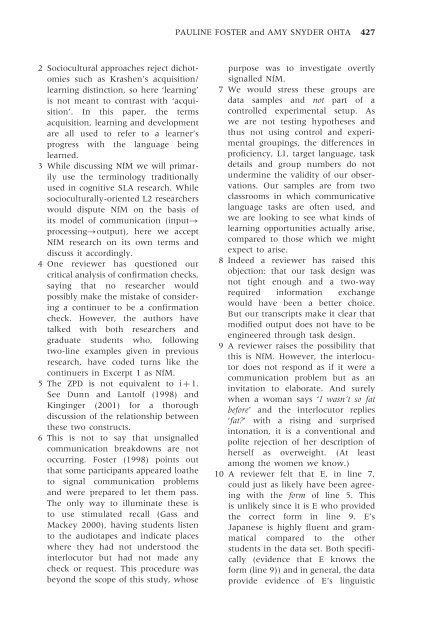Negotiation for Meaning and Peer Assistance in Second Language ...
Negotiation for Meaning and Peer Assistance in Second Language ...
Negotiation for Meaning and Peer Assistance in Second Language ...
You also want an ePaper? Increase the reach of your titles
YUMPU automatically turns print PDFs into web optimized ePapers that Google loves.
PAULINE FOSTER <strong>and</strong> AMY SNYDER OHTA 427<br />
2 Sociocultural approaches reject dichotomies<br />
such as Krashen’s acquisition/<br />
learn<strong>in</strong>g dist<strong>in</strong>ction, so here ‘learn<strong>in</strong>g’<br />
is not meant to contrast with ‘acquisition’.<br />
In this paper, the terms<br />
acquisition, learn<strong>in</strong>g <strong>and</strong> development<br />
are all used to refer to a learner’s<br />
progress with the language be<strong>in</strong>g<br />
learned.<br />
3 While discuss<strong>in</strong>g NfM we will primarily<br />
use the term<strong>in</strong>ology traditionally<br />
used <strong>in</strong> cognitive SLA research. While<br />
socioculturally-oriented L2 researchers<br />
would dispute NfM on the basis of<br />
its model of communication (<strong>in</strong>put!<br />
process<strong>in</strong>g!output), here we accept<br />
NfM research on its own terms <strong>and</strong><br />
discuss it accord<strong>in</strong>gly.<br />
4 One reviewer has questioned our<br />
critical analysis of confirmation checks,<br />
say<strong>in</strong>g that no researcher would<br />
possibly make the mistake of consider<strong>in</strong>g<br />
a cont<strong>in</strong>uer to be a confirmation<br />
check. However, the authors have<br />
talked with both researchers <strong>and</strong><br />
graduate students who, follow<strong>in</strong>g<br />
two-l<strong>in</strong>e examples given <strong>in</strong> previous<br />
research, have coded turns like the<br />
cont<strong>in</strong>uers <strong>in</strong> Excerpt 1 as NfM.<br />
5 The ZPD is not equivalent to i þ 1.<br />
See Dunn <strong>and</strong> Lantolf (1998) <strong>and</strong><br />
K<strong>in</strong>g<strong>in</strong>ger (2001) <strong>for</strong> a thorough<br />
discussion of the relationship between<br />
these two constructs.<br />
6 This is not to say that unsignalled<br />
communication breakdowns are not<br />
occurr<strong>in</strong>g. Foster (1998) po<strong>in</strong>ts out<br />
that some participants appeared loathe<br />
to signal communication problems<br />
<strong>and</strong> were prepared to let them pass.<br />
The only way to illum<strong>in</strong>ate these is<br />
to use stimulated recall (Gass <strong>and</strong><br />
Mackey 2000), hav<strong>in</strong>g students listen<br />
to the audiotapes <strong>and</strong> <strong>in</strong>dicate places<br />
where they had not understood the<br />
<strong>in</strong>terlocutor but had not made any<br />
check or request. This procedure was<br />
beyond the scope of this study, whose<br />
purpose was to <strong>in</strong>vestigate overtly<br />
signalled NfM.<br />
7 We would stress these groups are<br />
data samples <strong>and</strong> not part of a<br />
controlled experimental setup. As<br />
we are not test<strong>in</strong>g hypotheses <strong>and</strong><br />
thus not us<strong>in</strong>g control <strong>and</strong> experimental<br />
group<strong>in</strong>gs, the differences <strong>in</strong><br />
proficiency, L1, target language, task<br />
details <strong>and</strong> group numbers do not<br />
underm<strong>in</strong>e the validity of our observations.<br />
Our samples are from two<br />
classrooms <strong>in</strong> which communicative<br />
language tasks are often used, <strong>and</strong><br />
we are look<strong>in</strong>g to see what k<strong>in</strong>ds of<br />
learn<strong>in</strong>g opportunities actually arise,<br />
compared to those which we might<br />
expect to arise.<br />
8 Indeed a reviewer has raised this<br />
objection: that our task design was<br />
not tight enough <strong>and</strong> a two-way<br />
required <strong>in</strong><strong>for</strong>mation exchange<br />
would have been a better choice.<br />
But our transcripts make it clear that<br />
modified output does not have to be<br />
eng<strong>in</strong>eered through task design.<br />
9 A reviewer raises the possibility that<br />
this is NfM. However, the <strong>in</strong>terlocutor<br />
does not respond as if it were a<br />
communication problem but as an<br />
<strong>in</strong>vitation to elaborate. And surely<br />
when a woman says ‘I wasn’t so fat<br />
be<strong>for</strong>e’ <strong>and</strong> the <strong>in</strong>terlocutor replies<br />
‘fat?’ with a ris<strong>in</strong>g <strong>and</strong> surprised<br />
<strong>in</strong>tonation, it is a conventional <strong>and</strong><br />
polite rejection of her description of<br />
herself as overweight. (At least<br />
among the women we know.)<br />
10 A reviewer felt that E, <strong>in</strong> l<strong>in</strong>e 7,<br />
could just as likely have been agree<strong>in</strong>g<br />
with the <strong>for</strong>m of l<strong>in</strong>e 5. This<br />
is unlikely s<strong>in</strong>ce it is E who provided<br />
the correct <strong>for</strong>m <strong>in</strong> l<strong>in</strong>e 9. E’s<br />
Japanese is highly fluent <strong>and</strong> grammatical<br />
compared to the other<br />
students <strong>in</strong> the data set. Both specifically<br />
(evidence that E knows the<br />
<strong>for</strong>m (l<strong>in</strong>e 9)) <strong>and</strong> <strong>in</strong> general, the data<br />
provide evidence of E’s l<strong>in</strong>guistic














